Java中的StringStringBuilder以及StringBuffer
Posted xdyixia
tags:
篇首语:本文由小常识网(cha138.com)小编为大家整理,主要介绍了Java中的StringStringBuilder以及StringBuffer相关的知识,希望对你有一定的参考价值。
一.你了解String类吗?
二.深入理解String、StringBuffer、StringBuilder
三.不同场景下三个类的性能测试
四.常见的关于String、StringBuffer的面试题(辟谣网上流传的一些曲解String类的说法)
一.你了解String类吗?
想要了解一个类,最好的办法就是看这个类的实现源代码,String类的实现在
\\jdk1.6.0_14\\src\\java\\lang\\String.java 文件中。
打开这个类文件就会发现String类是被final修饰的:
1 public final class String 2 implements java.io.Serializable, Comparable<String>, CharSequence 3 { 4 /** The value is used for character storage. */ 5 private final char value[]; 6 7 /** The offset is the first index of the storage that is used. */ 8 private final int offset; 9 10 /** The count is the number of characters in the String. */ 11 private final int count; 12 13 /** Cache the hash code for the string */ 14 private int hash; // Default to 0 15 16 /** use serialVersionUID from JDK 1.0.2 for interoperability */ 17 private static final long serialVersionUID = -6849794470754667710L; 18 19 ...... 20 21 }
从上面可以看出几点:
1)String类是final类,也即意味着String类不能被继承,并且它的成员方法都默认为final方法。在Java中,被final修饰的类是不允许被继承的,并且该类中的成员方法都默认为final方法。在早期的JVM实现版本中,被final修饰的方法会被转为内嵌调用以提升执行效率。而从Java SE5/6开始,就渐渐摈弃这种方式了。因此在现在的Java SE版本中,不需要考虑用final去提升方法调用效率。只有在确定不想让该方法被覆盖时,才将方法设置为final。
2)上面列举出了String类中所有的成员属性,从上面可以看出String类其实是通过char数组来保存字符串的。
下面再继续看String类的一些方法实现:
1 public String substring(int beginIndex, int endIndex) { 2 if (beginIndex < 0) { 3 throw new StringIndexOutOfBoundsException(beginIndex); 4 } 5 if (endIndex > count) { 6 throw new StringIndexOutOfBoundsException(endIndex); 7 } 8 if (beginIndex > endIndex) { 9 throw new StringIndexOutOfBoundsException(endIndex - beginIndex); 10 } 11 return ((beginIndex == 0) && (endIndex == count)) ? this : 12 new String(offset + beginIndex, endIndex - beginIndex, value); 13 } 14 15 public String concat(String str) { 16 int otherLen = str.length(); 17 if (otherLen == 0) { 18 return this; 19 } 20 char buf[] = new char[count + otherLen]; 21 getChars(0, count, buf, 0); 22 str.getChars(0, otherLen, buf, count); 23 return new String(0, count + otherLen, buf); 24 } 25 26 public String replace(char oldChar, char newChar) { 27 if (oldChar != newChar) { 28 int len = count; 29 int i = -1; 30 char[] val = value; /* avoid getfield opcode */ 31 int off = offset; /* avoid getfield opcode */ 32 33 while (++i < len) { 34 if (val[off + i] == oldChar) { 35 break; 36 } 37 } 38 if (i < len) { 39 char buf[] = new char[len]; 40 for (int j = 0 ; j < i ; j++) { 41 buf[j] = val[off+j]; 42 } 43 while (i < len) { 44 char c = val[off + i]; 45 buf[i] = (c == oldChar) ? newChar : c; 46 i++; 47 } 48 return new String(0, len, buf); 49 } 50 } 51 return this;
从上面的三个方法可以看出,无论是substring、concat还是replace操作都不是在原有的字符串上进行的,而是重新生成了一个新的字符串对象。也就是说进行这些操作后,最原始的字符串并没有被改变。
在这里要永远记住一点:
“对String对象的任何改变都不影响到原对象,相关的任何change操作都会生成新的对象”。
在了解了于String类基础的知识后,下面来看一些在平常使用中容易忽略和混淆的地方。
二.深入理解String、StringBuffer、StringBuilder
1.String str="hello world"和String str=new String("hello world")的区别
想必大家对上面2个语句都不陌生,在平时写代码的过程中也经常遇到,那么它们到底有什么区别和联系呢?下面先看几个例子:
public class Main { public static void main(String[] args) { String str1 = "hello world"; String str2 = new String("hello world"); String str3 = "hello world"; String str4 = new String("hello world"); System.out.println(str1==str2); System.out.println(str1==str3); System.out.println(str2==str4); } }
这段代码的输出结果为

为什么会出现这样的结果?下面解释一下原因:
在前面一篇讲解关于JVM内存机制的一篇博文中提到 ,在class文件中有一部分 来存储编译期间生成的 字面常量以及符号引用,这部分叫做class文件常量池,在运行期间对应着方法区的运行时常量池。
因此在上述代码中,String str1 = "hello world";和String str3 = "hello world"; 都在编译期间生成了 字面常量和符号引用,运行期间字面常量"hello world"被存储在运行时常量池(当然只保存了一份)。通过这种方式来将String对象跟引用绑定的话,JVM执行引擎会先在运行时常量池查找是否存在相同的字面常量,如果存在,则直接将引用指向已经存在的字面常量;否则在运行时常量池开辟一个空间来存储该字面常量,并将引用指向该字面常量。
总所周知,通过new关键字来生成对象是在堆区进行的,而在堆区进行对象生成的过程是不会去检测该对象是否已经存在的。因此通过new来创建对象,创建出的一定是不同的对象,即使字符串的内容是相同的。
2.String、StringBuffer以及StringBuilder的区别
既然在Java中已经存在了String类,那为什么还需要StringBuilder和StringBuffer类呢?
那么看下面这段代码:
public class Main { public static void main(String[] args) { String string = ""; for(int i=0;i<10000;i++){ string += "hello"; } } }
这句 string += "hello";的过程相当于将原有的string变量指向的对象内容取出与"hello"作字符串相加操作再存进另一个新的String对象当中,再让string变量指向新生成的对象。如果大家还有疑问可以反编译其字节码文件便清楚了:
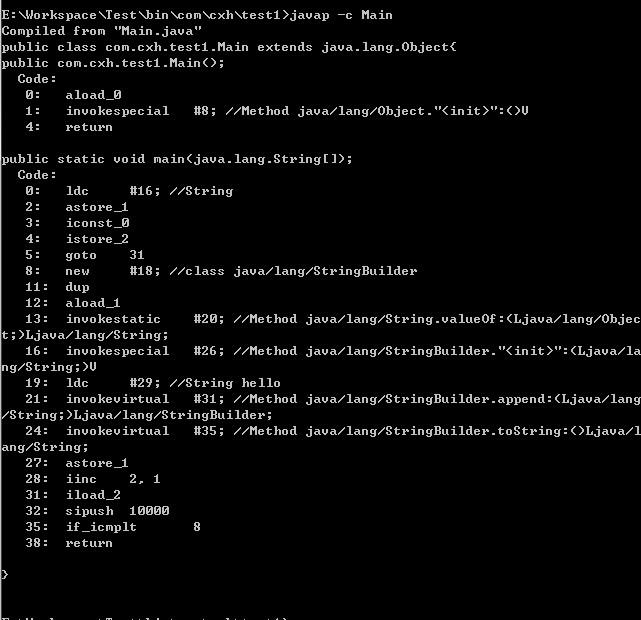
从这段反编译出的字节码文件可以很清楚地看出:从第8行开始到第35行是整个循环的执行过程,并且每次循环会new出一个StringBuilder对象,然后进行append操作,最后通过toString方法返回String对象。也就是说这个循环执行完毕new出了10000个对象,试想一下,如果这些对象没有被回收,会造成多大的内存资源浪费。从上面还可以看出:string+="hello"的操作事实上会自动被JVM优化成:
StringBuilder str = new StringBuilder(string);
str.append("hello");
str.toString();
再看下面这段代码:
1 public class Main { 2 3 public static void main(String[] args) { 4 StringBuilder stringBuilder = new StringBuilder(); 5 for(int i=0;i<10000;i++){ 6 stringBuilder.append("hello"); 7 } 8 } 9 }
反编译字节码文件得到:
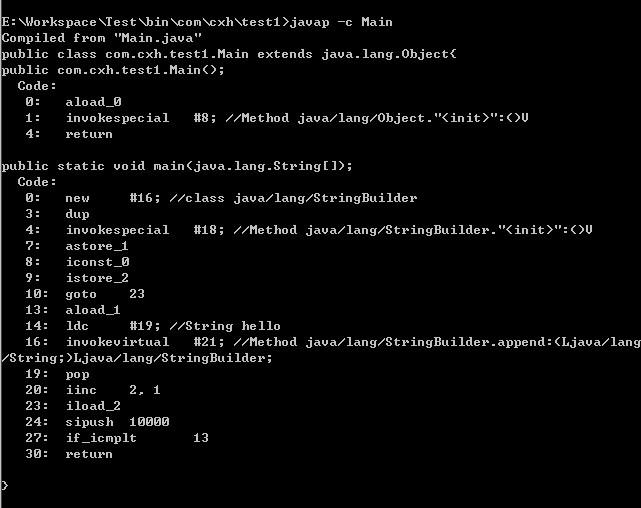
从这里可以明显看出,这段代码的for循环式从13行开始到27行结束,并且new操作只进行了一次,也就是说只生成了一个对象,append操作是在原有对象的基础上进行的。因此在循环了10000次之后,这段代码所占的资源要比上面小得多。
那么有人会问既然有了StringBuilder类,为什么还需要StringBuffer类?查看源代码便一目了然,事实上,StringBuilder和StringBuffer类拥有的成员属性以及成员方法基本相同,区别是StringBuffer类的成员方法前面多了一个关键字:synchronized,不用多说,这个关键字是在多线程访问时起到安全保护作用的,也就是说StringBuffer是线程安全的。
下面摘了2段代码分别来自StringBuffer和StringBuilder,insert方法的具体实现:
StringBuilder的insert方法
1 public StringBuilder insert(int index, char str[], int offset, 2 int len) 3 { 4 super.insert(index, str, offset, len); 5 return this; 6 }
StringBuffer的insert方法:
public synchronized StringBuffer insert(int index, char str[], int offset, int len) { super.insert(index, str, offset, len); return this; }
三.不同场景下三个类的性能测试
从第二节我们已经看出了三个类的区别,这一小节我们来做个小测试,来测试一下三个类的性能区别:

1 public class Main { 2 private static int time = 50000; 3 public static void main(String[] args) { 4 testString(); 5 testStringBuffer(); 6 testStringBuilder(); 7 test1String(); 8 test2String(); 9 } 10 11 12 public static void testString () { 13 String s=""; 14 long begin = System.currentTimeMillis(); 15 for(int i=0; i<time; i++){ 16 s += "java"; 17 } 18 long over = System.currentTimeMillis(); 19 System.out.println("操作"+s.getClass().getName()+"类型使用的时间为:"+(over-begin)+"毫秒"); 20 } 21 22 public static void testStringBuffer () { 23 StringBuffer sb = new StringBuffer(); 24 long begin = System.currentTimeMillis(); 25 for(int i=0; i<time; i++){ 26 sb.append("java"); 27 } 28 long over = System.currentTimeMillis(); 29 System.out.println("操作"+sb.getClass().getName()+"类型使用的时间为:"+(over-begin)+"毫秒"); 30 } 31 32 public static void testStringBuilder () { 33 StringBuilder sb = new StringBuilder(); 34 long begin = System.currentTimeMillis(); 35 for(int i=0; i<time; i++){ 36 sb.append("java"); 37 } 38 long over = System.currentTimeMillis(); 39 System.out.println("操作"+sb.getClass().getName()+"类型使用的时间为:"+(over-begin)+"毫秒"); 40 } 41 42 public static void test1String () { 43 long begin = System.currentTimeMillis(); 44 for(int i=0; i<time; i++){ 45 String s = "I"+"love"+"java"; 46 } 47 long over = System.currentTimeMillis(); 48 System.out.println("字符串直接相加操作:"+(over-begin)+"毫秒"); 49 } 50 51 public static void test2String () { 52 String s1 ="I"; 53 String s2 = "love"; 54 String s3 = "java"; 55 long begin = System.currentTimeMillis(); 56 for(int i=0; i<time; i++){ 57 String s = s1+s2+s3; 58 } 59 long over = System.currentTimeMillis(); 60 System.out.println("字符串间接相加操作:"+(over-begin)+"毫秒"); 61 } 62 63 }
测试结果(win7,Eclipse,JDK6):

上面提到string+="hello"的操作事实上会自动被JVM优化,看下面这段代码:

1 public class Main { 2 private static int time = 50000; 3 public static void main(String[] args) { 4 testString(); 5 testOptimalString(); 6 } 7 8 9 public static void testString () { 10 String s=""; 11 long begin = System.currentTimeMillis(); 12 for(int i=0; i<time; i++){ 13 s += "java"; 14 } 15 long over = System.currentTimeMillis(); 16 System.out.println("操作"+s.getClass().getName()+"类型使用的时间为:"+(over-begin)+"毫秒"); 17 } 18 19 public static void testOptimalString () { 20 String s=""; 21 long begin = System.currentTimeMillis(); 22 for(int i=0; i<time; i++){ 23 StringBuilder sb = new StringBuilder(s); 24 sb.append("java"); 25 s=sb.toString(); 26 } 27 long over = System.currentTimeMillis(); 28 System.out.println("模拟JVM优化操作的时间为:"+(over-begin)+"毫秒"); 29 } 30 31 }
执行结果:

得到验证。
下面对上面的执行结果进行一般性的解释:
1)对于直接相加字符串,效率很高,因为在编译器便确定了它的值,也就是说形如"I"+"love"+"java"; 的字符串相加,在编译期间便被优化成了"Ilovejava"。这个可以用javap -c命令反编译生成的class文件进行验证。
对于间接相加(即包含字符串引用),形如s1+s2+s3; 效率要比直接相加低,因为在编译器不会对引用变量进行优化。
2)String、StringBuilder、StringBuffer三者的执行效率:
StringBuilder > StringBuffer > String
当然这个是相对的,不一定在所有情况下都是这样。
比如String str = "hello"+ "world"的效率就比 StringBuilder st = new StringBuilder().append("hello").append("world")要高。
因此,这三个类是各有利弊,应当根据不同的情况来进行选择使用:
当字符串相加操作或者改动较少的情况下,建议使用 String str="hello"这种形式;
当字符串相加操作较多的情况下,建议使用StringBuilder,如果采用了多线程,则使用StringBuffer。
四.常见的关于String、StringBuffer的面试题(辟谣网上流传的一些曲解String类的说法)
1. 下面这段代码的输出结果是什么?
String a = "hello2"; String b = "hello" + 2; System.out.println((a == b));
输出结果为:true。原因很简单,"hello"+2在编译期间就已经被优化成"hello2",因此在运行期间,变量a和变量b指向的是同一个对象。
2.下面这段代码的输出结果是什么?
String a = "hello2"; String b = "hello"; String c = b + 2; System.out.println((a == c));
输出结果为:false。由于有符号引用的存在,所以 String c = b + 2;不会在编译期间被优化,不会把b+2当做字面常量来处理的,因此这种方式生成的对象事实上是保存在堆上的。因此a和c指向的并不是同一个对象。javap -c得到的内容:
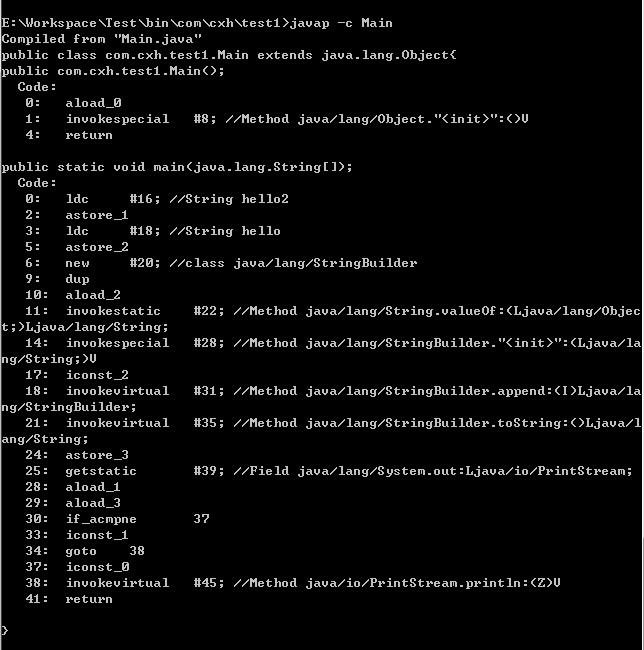
3.下面这段代码的输出结果是什么?
String a = "hello2"; final String b = "hello"; String c = b + 2; System.out.println((a == c));
输出结果为:true。对于被final修饰的变量,会在class文件常量池中保存一个副本,也就是说不会通过连接而进行访问,对final变量的访问在编译期间都会直接被替代为真实的值。那么String c = b + 2;在编译期间就会被优化成:String c = "hello" + 2; 下图是javap -c的内容:
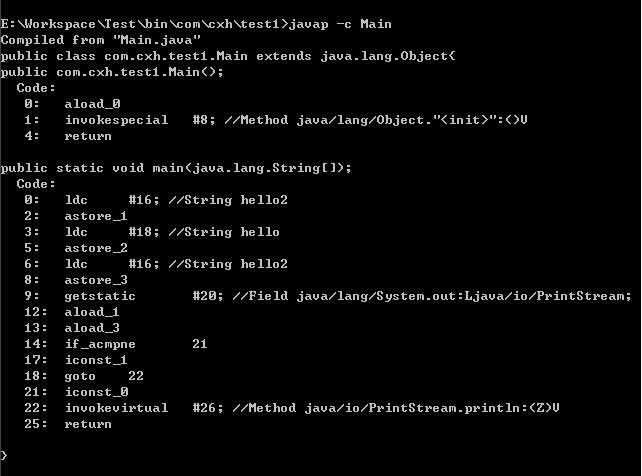
4.下面这段代码输出结果为:
1 public class Main { 2 public static void main(String[] args) { 3 String a = "hello2"; 4 final String b = getHello(); 5 String c = b + 2; 6 System.out.println((a == c)); 7 } 8 9 public static String getHello() { 10 return "hello"; 11 } 12 }
输出结果为false。这里面虽然将b用final修饰了,但是由于其赋值是通过方法调用返回的,那么它的值只能在运行期间确定,因此a和c指向的不是同一个对象。
5.下面这段代码的输出结果是什么?
1 public class Main { 2 public static void main(String[] args) { 3 String a = "hello"; 4 String b = new String("hello"); 5 String c = new String("hello"); 6 String d = b.intern(); 7 8 System.out.println(a==b); 9 System.out.println(b==c); 10 System.out.println(b==d); 11 System.out.println(a==d); 12 } 13 }
输出结果为(JDK版本 JDK8):

这里面涉及到的是String.intern方法的使用。在String类中,intern方法是一个本地方法,在JAVA SE6之前,intern方法会在运行时常量池中查找是否存在内容相同的字符串,如果存在则返回指向该字符串的引用,如果不存在,则会将该字符串入池,并返回一个指向该字符串的引用。因此,a和d指向的是同一个对象。
6.String str = new String("abc")创建了多少个对象?
这个问题在很多书籍上都有说到比如《Java程序员面试宝典》,包括很多国内大公司笔试面试题都会遇到,大部分网上流传的以及一些面试书籍上都说是2个对象,这种说法是片面的。
如果有不懂得地方可以参考这篇帖子:
http://rednaxelafx.iteye.com/blog/774673/
首先必须弄清楚创建对象的含义,创建是什么时候创建的?这段代码在运行期间会创建2个对象么?毫无疑问不可能,用javap -c反编译即可得到JVM执行的字节码内容:
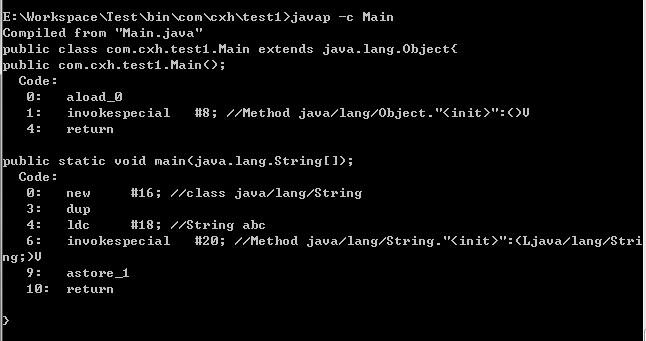
很显然,new只调用了一次,也就是说只创建了一个对象。
而这道题目让人混淆的地方就是这里,这段代码在运行期间确实只创建了一个对象,即在堆上创建了"abc"对象。而为什么大家都在说是2个对象呢,这里面要澄清一个概念 该段代码执行过程和类的加载过程是有区别的。在类加载的过程中,确实在运行时常量池中创建了一个"abc"对象,而在代码执行过程中确实只创建了一个String对象。
因此,这个问题如果换成 String str = new String("abc")涉及到几个String对象?合理的解释是2个。
个人觉得在面试的时候如果遇到这个问题,可以向面试官询问清楚”是这段代码执行过程中创建了多少个对象还是涉及到多少个对象“再根据具体的来进行回答。
7.下面这段代码1)和2)的区别是什么?
1 public class Main { 2 public static void main(String[] args) { 3 String str1 = "I"; 4 //str1 += "love"+"java"; 1) 5 str1 = str1+"love"+"java"; //2) 6 7 } 8 }
1)的效率比2)的效率要高,1)中的"love"+"java"在编译期间会被优化成"lovejava",而2)中的不会被优化。下面是两种方式的字节码:
1)的字节码:
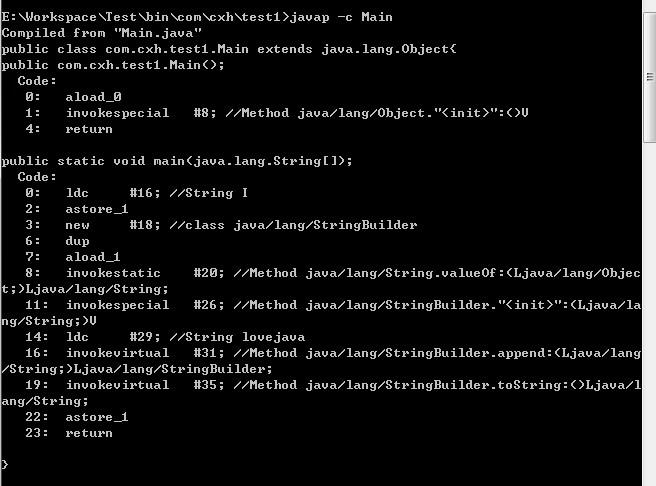
2)的字节码:
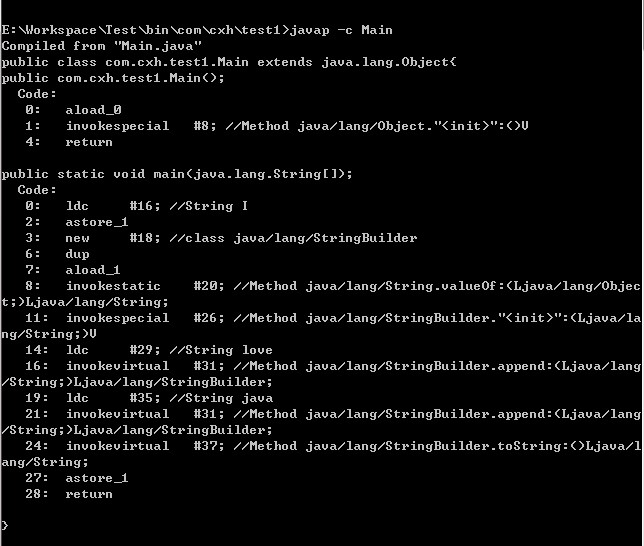
可以看出,在1)中只进行了一次append操作,而在2)中进行了两次append操作。
参考文章:
http://rednaxelafx.iteye.com/blog/774673/
http://www.blogjava.net/Jack2007/archive/2008/06/17/208602.html
http://www.jb51.net/article/36041.htm
http://blog.csdn.net/yirentianran/article/details/2871417
http://www.jb51.net/article/33398.htm
转自:https://www.cnblogs.com/dolphin0520/p/3778589.html
以上是关于Java中的StringStringBuilder以及StringBuffer的主要内容,如果未能解决你的问题,请参考以下文章
